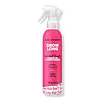What's inside
What's inside
 Key Ingredients
Key Ingredients

 Benefits
Benefits

 Concerns
Concerns

 Ingredients Side-by-side
Ingredients Side-by-side

Water
Skin ConditioningCetyl Alcohol
EmollientBehentrimonium Chloride
PreservativeParfum
MaskingPhenoxyethanol
PreservativeCaffeine
Skin ConditioningTocopheryl Acetate
AntioxidantPanax Ginseng Root Extract
EmollientBiotin
AntiseborrhoeicCocos Nucifera Oil
MaskingStearyl Alcohol
EmollientPropylene Glycol
HumectantCyclopentasiloxane
EmollientDivinyldimethicone/Dimethicone Copolymer
Isopropyl Alcohol
SolventAmodimethicone
Ethylhexylglycerin
Skin ConditioningC12-13 Pareth-3
EmulsifyingCetrimonium Chloride
AntimicrobialTrideceth-12
EmulsifyingC12-13 Pareth-23
CleansingButylene Glycol
HumectantSodium Hydroxide
BufferingWater, Cetyl Alcohol, Behentrimonium Chloride, Parfum, Phenoxyethanol, Caffeine, Tocopheryl Acetate, Panax Ginseng Root Extract, Biotin, Cocos Nucifera Oil, Stearyl Alcohol, Propylene Glycol, Cyclopentasiloxane, Divinyldimethicone/Dimethicone Copolymer, Isopropyl Alcohol, Amodimethicone, Ethylhexylglycerin, C12-13 Pareth-3, Cetrimonium Chloride, Trideceth-12, C12-13 Pareth-23, Butylene Glycol, Sodium Hydroxide
Water
Skin ConditioningPropylene Glycol
HumectantCetearyl Alcohol
EmollientCyclopentasiloxane
EmollientBehentrimonium Chloride
PreservativeQuaternium-80
Phenoxyethanol
PreservativeParfum
MaskingMethylparaben
PreservativePanthenol
Skin ConditioningPropylparaben
PreservativeEthylparaben
PreservativeAloe Barbadensis Leaf Juice
Skin ConditioningButylene Glycol
HumectantSodium Hydroxide
BufferingHydrolyzed Keratin
HumectantKeratin Amino Acids
Skin ConditioningHelianthus Annuus Seed Extract
Skin ConditioningSilk Amino Acids
HumectantCamellia Sinensis Leaf Extract
AntimicrobialBenzyl Benzoate
AntimicrobialBenzyl Salicylate
PerfumingHydroxycitronellal
PerfumingLinalool
PerfumingWater, Propylene Glycol, Cetearyl Alcohol, Cyclopentasiloxane, Behentrimonium Chloride, Quaternium-80, Phenoxyethanol, Parfum, Methylparaben, Panthenol, Propylparaben, Ethylparaben, Aloe Barbadensis Leaf Juice, Butylene Glycol, Sodium Hydroxide, Hydrolyzed Keratin, Keratin Amino Acids, Helianthus Annuus Seed Extract, Silk Amino Acids, Camellia Sinensis Leaf Extract, Benzyl Benzoate, Benzyl Salicylate, Hydroxycitronellal, Linalool
 Reviews
Reviews

Ingredients Explained
These ingredients are found in both products.
Ingredients higher up in an ingredient list are typically present in a larger amount.
This ingredient is a preservative and often used for it's anti-static properties. You'll most likely see this ingredient in hair conditioners.
It does not cause irritation or sensitization in leave-on products at 1-5%.
Butylene Glycol (or BG) is used within cosmetic products for a few different reasons:
Overall, Butylene Glycol is a safe and well-rounded ingredient that works well with other ingredients.
Though this ingredient works well with most skin types, some people with sensitive skin may experience a reaction such as allergic rashes, closed comedones, or itchiness.
Learn more about Butylene GlycolCyclopentasiloxane, or D5, is a silicone used to improve texture of products and trap moisture.
D5 is considered lightweight and volatile. Volatile means it evaporates quickly after application. Once evaporated, D5 leaves a thin barrier that helps keep skin hydrated.
It is also an emollient. Emollients help soften the skin and prevent water loss. Silicones create a silky texture in products. D5 helps other ingredients become more spreadable.
Studies show D5 is safe to use in skincare products. We recommend speaking with a skincare professional if you have concerns.
Learn more about CyclopentasiloxaneParfum is a catch-all term for an ingredient or more that is used to give a scent to products.
Also called "fragrance", this ingredient can be a blend of hundreds of chemicals or plant oils. This means every product with "fragrance" or "parfum" in the ingredients list is a different mixture.
For instance, Habanolide is a proprietary trade name for a specific aroma chemical. When used as a fragrance ingredient in cosmetics, most aroma chemicals fall under the broad labeling category of “FRAGRANCE” or “PARFUM” according to EU and US regulations.
The term 'parfum' or 'fragrance' is not regulated in many countries. In many cases, it is up to the brand to define this term.
For instance, many brands choose to label themselves as "fragrance-free" because they are not using synthetic fragrances. However, their products may still contain ingredients such as essential oils that are considered a fragrance by INCI standards.
One example is Calendula flower extract. Calendula is an essential oil that still imparts a scent or 'fragrance'.
Depending on the blend, the ingredients in the mixture can cause allergies and sensitivities on the skin. Some ingredients that are known EU allergens include linalool and citronellol.
Parfum can also be used to mask or cover an unpleasant scent.
The bottom line is: not all fragrances/parfum/ingredients are created equally. If you are worried about fragrances, we recommend taking a closer look at an ingredient. And of course, we always recommend speaking with a professional.
Learn more about ParfumPhenoxyethanol is a preservative that has germicide, antimicrobial, and aromatic properties. Studies show that phenoxyethanol can prevent microbial growth. By itself, it has a scent that is similar to that of a rose.
It's often used in formulations along with Caprylyl Glycol to preserve the shelf life of products.
Propylene Glycol is an odorless, colorless liquid. As a humectant, it helps skin retain moisture. It also aids in delivering active ingredients.
Another role of this ingredient is preventing a product from melting or freezing. Propylene glycol also adds antimicrobrial properties to a product, elongating product lifespan.
This ingredient is considered an organic alcohol and commonly added into both cosmetics and foods.
Those with sensitive skin or conditions may develop a rash when using this ingredient.
Learn more about Propylene GlycolSodium Hydroxide is also known as lye or caustic soda. It is used to adjust the pH of products; many ingredients require a specific pH to be effective.
In small amounts, sodium hydroxide is considered safe to use. However, large amounts may cause chemical burns due to its high alkaline.
Your skin has a natural pH and acid mantle. This acid mantle helps prevent harmful bacteria from breaking through. The acid mantle also helps keep your skin hydrated.
"Alkaline" refers to a high pH level. A low pH level would be considered acidic.
Learn more about Sodium HydroxideWater. It's the most common cosmetic ingredient of all. You'll usually see it at the top of ingredient lists, meaning that it makes up the largest part of the product.
So why is it so popular? Water most often acts as a solvent - this means that it helps dissolve other ingredients into the formulation.
You'll also recognize water as that liquid we all need to stay alive. If you see this, drink a glass of water. Stay hydrated!
Learn more about Water